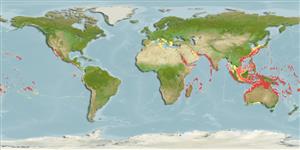Common names from other countries
Environment: milieu / climate zone / depth range / distribution range
экология
; пределы глубины 0 - 150 m (Ref. 93550), usually 0 - 50 m (Ref. 75831). Tropical
Indo-Pacific and the Mediterranean Sea. Tropical and subtropical.
Length at first maturity / Size / Вес / Возраст
Maturity: Lm ? range ? - ? cm Max length : 0.4 cm TL самец/пол неопределен; (Ref. 2922)
Found in low tidal to 130 m in crevices and stones; dead specimens to 274 m (Ref. 337); also intertidal on rocks and coral (Ref. 75831). Commonly attached via strong byssal threads to the undersides of rock slabs and boulders in the lower eulittoral subzone and to dead coral and rocks in the shallow subtidal (Ref. 102838). Also found on fine gray sand (Ref. 77792). Reported from Hong Kong to be found on the ceilings and walls of submarine caves (Ref. 126058).
Life cycle and mating behavior
половая зрелость | размножение | нерест | икра | Fecundity | личинки
Members of the class Bivalvia are mostly gonochoric, some are protandric hermaphrodites. Life cycle: Embryos develop into free-swimming trocophore larvae, succeeded by the bivalve veliger, resembling a miniature clam.
Основная ссылка
ссылки | координатор | соавторы
Raines, B. and M. Huber. 2012. (Ref. 93550)
Статус Красного Списка МСОП (Ref. 130435)
Статус СИТЕС (Ref. 108899)
Not Evaluated
Not Evaluated
Угроза для людей
Harmless
Использование человеком
| FishSource |
инструменты
дополнительная информация
Возраст/Размеры
рост
Зависимость между длиной и массой тела
Зависимость между длинами
морфология
личинки
численность
ресурсы в Интернет
Estimates based on models
Preferred temperature
(Ref.
115969): 21.2 - 29, mean 27.4 (based on 1826 cells).
Уязвимость
Low vulnerability (10 of 100).
